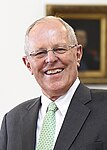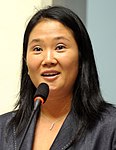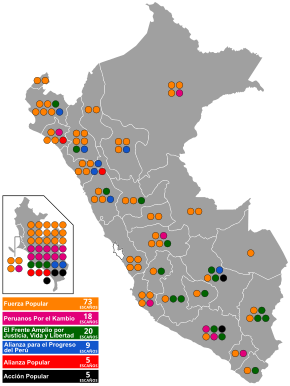You can help expand this article with text translated from the corresponding article in Spanish. (March 2016) Click for important translation instructions.
|
|
| ||||||||||||||||||||||||||||||||||||||||||||
| Presidential election | ||||||||||||||||||||||||||||||||||||||||||||
| ||||||||||||||||||||||||||||||||||||||||||||
| Turnout | 81.80% (first round) 80.09% (second round) | |||||||||||||||||||||||||||||||||||||||||||
|---|---|---|---|---|---|---|---|---|---|---|---|---|---|---|---|---|---|---|---|---|---|---|---|---|---|---|---|---|---|---|---|---|---|---|---|---|---|---|---|---|---|---|---|---|
| ||||||||||||||||||||||||||||||||||||||||||||
 Results of the second round by region (left) and province (right). Darker shades indicate a higher vote share. Results of the second round by region (left) and province (right). Darker shades indicate a higher vote share. | ||||||||||||||||||||||||||||||||||||||||||||
| ||||||||||||||||||||||||||||||||||||||||||||
| Congressional election | ||||||||||||||||||||||||||||||||||||||||||||
| ||||||||||||||||||||||||||||||||||||||||||||
All 130 seats in the Congress of Peru 66 seats needed for a majority | ||||||||||||||||||||||||||||||||||||||||||||
| ||||||||||||||||||||||||||||||||||||||||||||
| Politics of Peru |
|---|
 |
| Constitution |
Executive
|
|
Legislature Eduardo Salhuana |
|
Judiciary Supreme Court of the Republic |
Autonomies
|
| Elections |
Administrative divisions
|
Foreign relations
|
|
|
General elections were held in Peru on 10 April 2016 to determine the president, vice-presidents, composition of the Congress of the Republic of Peru and the Peruvian representatives of the Andean Parliament.
In the race for the presidency, incumbent President Ollanta Humala was ineligible for re-election due to constitutional term limits. Popular Force candidate Keiko Fujimori, daughter of former President Alberto Fujimori, was the leading candidate in the first round with almost 40 per cent of the vote, but fell short of the 50 per cent majority required to avoid a second round. Peruvians for Change candidate Pedro Pablo Kuczynski narrowly beat Broad Front candidate Verónika Mendoza to finish in second and earn a place in the second round. The run-off was held on 5 June 2016. With support from those opposing Fujimori, Kuczynski won by a narrow margin of less than half a percentage point, making this the first presidential election since 2000 in which the previous election's runner-up candidate failed to secure election. He was sworn in as President on 28 July.
In the Congressional elections, Popular Force won in a landslide, receiving more than a third of the vote and winning an absolute majority of 73 out of 130 seats. Broad Front with 20 seats and Peruvians for Change with 18 seats emerged as the main opposition blocs.
Background
On 13 November 2015, incumbent President Ollanta Humala called for a general election to be held on 10 April 2016. He said that he would respect the constitutional term limit restrictions and would not run again.
Electoral system
The President was elected using the two-round system. The 130 members of the Congress of the Republic were elected in 25 multi-member constituencies using open list proportional representation.
Presidential nominees
Campaign highlights
The presidential tickets were to be filed with the National Office of Electoral Processes (ONPE) by 10 January 2016. Congressional lists were to be filed with the ONPE by 10 February 2016.
In March 2016, presidential candidates Julio Guzmán from All for Peru and César Acuña Peralta from Alliance for Progress were barred from the elections; Guzmán due to a violation of party rules in the party's internal election and Acuña Peralta due to monetary giveaways during a campaign rally, a violation of an electoral law enacted by Congress in November 2015.
Keiko Fujimori was a highly polarizing figure during the election. The daughter of the controversial former president Alberto Fujimori, who was serving time in prison at the time, she was popular among the poor and loyalists who credit her father with the defeat of Shining Path. This popularity allowed her to win in the first round of the presidential elections. She was viewed unfavorably by a number of people who oppose Fujimori for human rights abuses and corrupt practices, and who feared that her victory would mark a return of Fujimorismo. Mendoza, who placed third and could not stand in the runoff election, gave her full endorsement to Kuczynski, in order to prevent Fujimori's victory.
Main presidential nominees
| Presidential tickets | ||||
| Popular Action | Popular Force | Popular Alliance | Peruvians for Change | Broad Front |
 |
 |
 |
 | |
| Alfredo Barnechea | Keiko Fujimori | Alan García | Pedro Pablo Kuczynski | Verónika Mendoza |
|---|---|---|---|---|
 |
 |
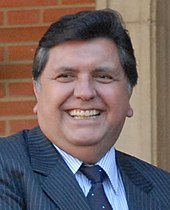 |
 |
 |
| Member of Congress (1985–1990) |
Member of Congress (2006–2011) |
President of Peru (1985–1990 / 2006–2011) |
President of the Council of Ministers (2005–2006) |
Member of Congress (2011–2016) |
| Running mates | ||||
| 1st: Víctor A. García Belaúnde 2nd: Edmundo del Águila |
1st: José Chlimper 2nd: Vladimiro Huaroc |
1st: Lourdes Flores 2nd: David Salazar |
1st: Martín Vizcarra 2nd: Mercedes Aráoz |
1st: Marco Arana 2nd: Alan Fairlie |
- Alfredo Barnechea is Popular Action's nominee. A renowned journalist in the 1980s, his first stint in politics occurred in 1983, as he ran for mayor of Lima with the APRA, losing to Alfonso Barrantes. Elected to the lower house Peruvian Congress in 1985, he quit the party and remained in opposition to Alan García. Participating in the 1990 Democratic Front campaign, he subsequently attained a master's degree in public administration from Harvard Kennedy School. A member of Popular Action since 2013, ideologically he considers himself a social democrat.
- Keiko Fujimori, is the nominee and leader of the conservative Popular Force. She is the daughter of former President Alberto Fujimori, who serves in prison for a series of crimes and human rights violations during his presidency. A graduate of Columbia Business School, she served in the Peruvian Congress from 2006 to 2011, and made it to the run-off with Ollanta Humala in the 2011 election, losing by a small margin. Her nomination remained a highly polarizing one throughout the election.
- Alan García, is the leader of the social democrat APRA and Popular Alliance's nominee. One of the two former presidents running in the election, this was his fourth and final run before his suicide in 2019. His first presidency from 1985 to 1990 is considered by historians a failure due to the country's period of instability caused by terrorism and a severe economic crisis, in contrast to his second presidency, which is regarded a success based on the steady economy experienced and poverty reduction, although marred by corruption accusations. In this election, he ran under an electoral coalition with the Christian People's Party and Go Peru, with former presidential nominee Lourdes Flores as his first running mate. Academically, he holds a law degree from the National University of San Marcos, and a master's in sociology at the University of Paris 1 Pantheon-Sorbonne.
- Pedro Pablo Kuczynski, is the nominee and leader of the liberal conservative Peruvians for Change. A prominent economist from the University of Oxford and Princeton University, this was his second presidential run following his third place in 2011. He served in Alejandro Toledo's presidency as Prime Minister and Minister of Economy and Finance, in addition to serving as Minister of Energy and Mines in the second presidency of Fernando Belaúnde.
- Verónika Mendoza, is Broad Front's nominee, a socialist coalition. A psychology major from the Paris Diderot University, she served in the Peruvian Congress from 2011 to 2016, representing the constituency of Cuzco, elected under the Peru Wins coalition of ex-president Ollanta Humala, but later left it. Throughout the campaign, she received much criticism for her left-wing policies, and for previous refusing to call Venezuela "a dictatorship" under Hugo Chávez and Nicolás Maduro.
Minor presidential nominees
- Alejandro Toledo, former President of Peru (2001–2006) – Possible Peru
- Gregorio Santos, former Governor of Cajamarca (2011–2014) – Direct Democracy
- Antero Flores Aráoz, former Minister of Defense (2007–2009) – Order
- Miguel Hilario – Peru Progressing
- Fernando Olivera, former Minister of Justice (2001–2002) – Hope Front
Withdrawn nominees
| Party | Ticket | Withdrawal | |||
|---|---|---|---|---|---|
| Name | for President | for First Vice President | for Second Vice President | Date | Motive |
| Always Together Siempre Unidos |
Felipe Castillo | Guillermo Ruiz | Isaac Humala | 10 February 2016 | Internal party disputes. |
| Peru Secure Homeland Perú Patria Segura |
Renzo Reggiardo | Carlos Vicente Marca | Miluska Carrasco | Nominee claimed lack of credibility in the electoral process. | |
| Peruvian Nationalist Party Partido Nacionalista Peruano |
Daniel Urresti | Susana Villarán | Maciste Díaz | 11 March 2016 | Party filed for withdrawal in order to preserve party registration. |
| Libertarian Perú Perú Libertario |
Vladimir Cerrón | Jorge Paredes Terry | Jesús Zárate | 24 March 2016 | In protest of the National Jury of Elections for not disqualifying Keiko Fujimori. |
| Peruvian Humanist Party Partido Humanista Peruano |
Yehude Simon | Rosa Mavila | Yorka Gamarra | 28 March 2016 | Party filed for withdrawal in order to preserve party registration. |
| Peru Nation Perú Nación |
Francisco Diez Canseco | Claudio Zolla | Margarita Gamboa | 29 March 2016 | Party filed for withdrawal in order to preserve party registration. |
| National Solidarity Solidaridad Nacional |
Hernando Guerra García | José Luna | Gustavo Rondón | Party filed for withdrawal in order to preserve party registration. | |
Disqualified nominees
| Party | Ticket | Disqualification | |||
|---|---|---|---|---|---|
| Name | for President | for First Vice President | for Second Vice President | Date | Motive |
| Alliance for the Progress of Peru Alianza para el Progreso del Perú |
César Acuña | Anel Townsend | Humberto Lay | 9 March 2016 | Disqualified for attempted vote buying in campaign trail. |
| All for Peru Todos por el Perú |
Julio Guzmán | Juana Umasi | Carolina Lizárraga | 9 March 2016 | Disqualified for irregularities in nomination process. |
Opinion polls
Main article: Opinion polling for the 2016 Peruvian general electionResults
President
The first round was held on 10 April. Exit polls indicated that Keiko Fujimori placed first in the first round of voting with approximately 40% of the vote, with Pedro Pablo Kuczynski and Veronika Mendoza each receiving approximately 20%.
The second round was held on 5 June. Exit polls indicated that Pedro Pablo Kuczynski held a slight lead over Keiko Fujimori. As counting continued, the gap narrowed significantly. Preliminary results gave Kuczynski a 0.25 per cent advantage over Fujimori, with less than 50,000 votes between them. Approximately 50,000 votes were challenged during the count. Fujimori conceded the election to Kuczynski on 10 June.
| Candidate | Party | First round | Second round | |||
|---|---|---|---|---|---|---|
| Votes | % | Votes | % | |||
| Keiko Fujimori | Popular Force | 6,115,073 | 39.86 | 8,555,880 | 49.88 | |
| Pedro Pablo Kuczynski | Peruvians for Change | 3,228,661 | 21.05 | 8,596,937 | 50.12 | |
| Verónika Mendoza | Broad Front | 2,874,940 | 18.74 | |||
| Alfredo Barnechea | Popular Action | 1,069,360 | 6.97 | |||
| Alan García | Popular Alliance | 894,278 | 5.83 | |||
| Gregorio Santos | Direct Democracy | 613,173 | 4.00 | |||
| Fernando Olivera | Hope Front | 203,103 | 1.32 | |||
| Alejandro Toledo | Possible Peru | 200,012 | 1.30 | |||
| Miguel Hilario | Peru Progressing | 75,870 | 0.49 | |||
| Antero Flores Aráoz | Order | 65,673 | 0.43 | |||
| Total | 15,340,143 | 100.00 | 17,152,817 | 100.00 | ||
| Valid votes | 15,340,143 | 81.88 | 17,152,817 | 93.51 | ||
| Invalid/blank votes | 3,393,987 | 18.12 | 1,190,079 | 6.49 | ||
| Total votes | 18,734,130 | 100.00 | 18,342,896 | 100.00 | ||
| Registered voters/turnout | 22,901,954 | 81.80 | 22,901,954 | 80.09 | ||
| Source: ONPE, ONPE | ||||||
Congress
Popular Force won in a landslide, taking more than a third of the vote and an absolute majority of 73 out of 130 seats. Behind them in opposition, Peruvians for Change with 18 seats and Broad Front with 20 seats. Other parties which gained representation in Congress include Alliance for the Progress of Peru (9 seats), Popular Alliance (5 seats) and Popular Action (5 seats).
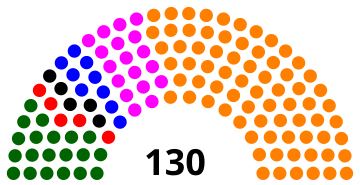 | ||||
|---|---|---|---|---|
| Party | Votes | % | Seats | |
| Popular Force | 4,431,077 | 36.34 | 73 | |
| Peruvians for Change | 2,007,710 | 16.46 | 18 | |
| Broad Front | 1,700,052 | 13.94 | 20 | |
| Alliance for the Progress of Peru | 1,125,682 | 9.23 | 9 | |
| Popular Alliance | 1,013,735 | 8.31 | 5 | |
| Popular Action | 877,734 | 7.20 | 5 | |
| Direct Democracy | 528,301 | 4.33 | 0 | |
| Possible Peru | 286,980 | 2.35 | 0 | |
| Hope Front | 139,634 | 1.15 | 0 | |
| Order | 68,474 | 0.56 | 0 | |
| Peru Progressing | 14,663 | 0.12 | 0 | |
| Total | 12,194,042 | 100.00 | 130 | |
| Valid votes | 12,194,042 | 65.03 | ||
| Invalid/blank votes | 6,557,222 | 34.97 | ||
| Total votes | 18,751,264 | 100.00 | ||
| Registered voters/turnout | 22,901,954 | 81.88 | ||
| Source: JNE | ||||
Andean Parliament
Only the three main parties obtained representation in the Andean Parliament, with Popular Force obtaining 3 seats (plus six substitutes) each, and Broad Front and Peruvians for Change obtaining only one seat (and two substitutes). Popular Force got the most votes, with 38.1% of the valid ballots. Former congressman Rolando Sousa of Popular Force obtained the most individual votes, with 407,811.
| Party | Votes | % | Seats | |
|---|---|---|---|---|
| Popular Force | 3,842,651 | 38.10 | 3 | |
| Broad Front | 1,559,027 | 15.46 | 1 | |
| Peruvians for Change | 1,505,118 | 14.92 | 1 | |
| Popular Alliance | 821,492 | 8.14 | 0 | |
| Popular Action | 807,585 | 8.01 | 0 | |
| Alliance for the Progress of Peru | 763,792 | 7.57 | 0 | |
| Direct Democracy | 506,108 | 5.02 | 0 | |
| Possible Peru | 220,790 | 2.19 | 0 | |
| Order | 59,318 | 0.59 | 0 | |
| Total | 10,085,881 | 100.00 | 5 | |
| Valid votes | 10,085,881 | 53.78 | ||
| Invalid/blank votes | 8,666,467 | 46.22 | ||
| Total votes | 18,752,348 | 100.00 | ||
| Registered voters/turnout | 22,901,954 | 81.88 | ||
| Source: JNE | ||||
Notes
- Excluded from campaign
References
- "Ollanta Humala convoca a elecciones generales para el 2016". El Comercio (in Spanish). 13 November 2015.
- Peru IFES
- ^ "Peru presidential candidates Guzman and Acuna banned from election". BBC. 9 March 2016. Retrieved 9 March 2016.
- Dan Collyns (7 June 2016). "Kuczynski ahead in Peru election, but will he be able to govern?". The Guardian. Retrieved 22 May 2016.
- Taj, Mitra; 30 September 2016. "AQ Top 5 Politicians Under 40: Verónika Mendoza". Americas Quarterly. Retrieved 26 November 2020.
{{cite web}}: CS1 maint: numeric names: authors list (link) - La República, Plataforma (10 February 2016). "Felipe Castillo renuncia a candidatura presidencial". larepublica.pe. Retrieved 19 February 2021.
- El Comercio, Redacción (19 February 2016). "Renzo Reggiardo renunció a su candidatura a la presidencia". elcomercio.pe. Retrieved 19 February 2021.
- El Comercio, Redacción (11 March 2016). "Partido Nacionalista retiró la candidatura de Daniel Urresti". elcomercio.pe. Retrieved 19 February 2021.
- "Vladimir Cerrón abandonó las Elecciones Generales del 2016". El Comercio (in Spanish). 24 March 2016. Retrieved 24 March 2016.
- "Yehude Simon anuncia retiro de su candidatura presidencial". La República (in Spanish). 28 March 2016. Retrieved 28 March 2016.
- "Francisco Diez-Canseco renunció a su candidatura presidencial". El Comercio (in Spanish). 29 March 2016. Retrieved 29 March 2016.
- "Solidaridad Nacional retira candidatura de Nano Guerra García". El Comercio (in Spanish). 29 March 2016. Retrieved 29 March 2016.
- "ONPE - Oficina Nacional de Procesos Electorales". www.web.onpe.gob.pe (in Spanish). Retrieved 23 November 2018.
- "Peru election: Keiko Fujimori wins first round, say exit polls – BBC News". BBC News. 11 April 2016. Retrieved 11 April 2016.
- "Peru election: Kuczynski wins, but Fujimori has yet to concede". BBC News. Retrieved 11 June 2016.
- "Peru elections: Keiko Fujimori concedes to Kuczynski". BBC News. Retrieved 11 June 2016.
- "ELECTION FOR CONGRESO DE LA REPÚBLICA 2016". Retrieved 1 June 2016.
| Presidential elections | |
|---|---|
| Parliamentary elections | |
| Regional elections | |
| Municipal elections | |
| Referendums | |
